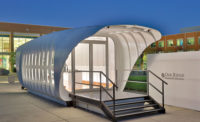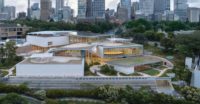Among SOM's many current— projects is an office and hotel complex in Shenzhen, China, now under construction for the Shen Ye Land Company and slated to be complete by mid-2017. To deliver the desired openness within a pristine envelope, the architects designed two towers—one 984 feet tall and the other 1,276 feet tall—each with a reinforced-concrete core and minimal perimeter structure, enclosed in large expanses of glass.
The buildings' typical vision-glass panel will be about 77 square feet—slightly larger than what is considered the maximum for standard-sized insulated glazing units (IGUs), says Holt. Instead of using tall and narrow IGUs to span from one floor to another, the design team specified a wider but shorter insulated unit, 9 feet, 10' inches wide by 7 feet, 10½ inches high. Made up of a laminated outer lite and a fully tempered inner lite, the vision glass will be positioned between a skinny lower lite and a highly insulated spandrel panel. 'Instead of thinking vertically, we turned the module on its side,' Holt says, to provide a wider field of vision for occupants.
Size isn't all that matters when it comes to selecting the right cladding. As the architects evaluate the Shen Ye towers' potential suppliers, they are considering the performance and appearance of their coatings, frits, and low-iron glazing—glass that is ultra-clear with a reduced greenish tint. The project team will also be keeping an eye out for surface imperfections like those known as 'roller waves'—an optical distortion that can result from heat tempering or heat strengthening.
Factors that could compromise the precision of the skin aren't limited to the manufacturing process. Problems during assembly, transportation, and installation can mar the facade.Even a building's day-to-day operations can blemish a meticulously detailed enclosure. Holt points to 'pillowing'—a slight but visible bowing of the skin caused by a pressure differential between a tower's interior and exterior imparted by mechanical systems or the stack effect.
SOM's method for combating this phenomenon involves IGUs with extra-thick—5/8 inch—outer lites, which will also help counter the wind deflection caused by the region's occasional typhoons. But the all-glass skin will still be much lighter than other cladding schemes, such as masonry with ribbon windows, he says, and 'it makes beautiful buildings."

To earn one AIA learning unit (LU), including one hour of health, safety, and welfare (HSW) credit, read each of the articles below, and complete the test online. Upon passing, you will receive a certificate of completion and your credit will automatically be reported to the AIA. Find additional information regarding credit-reporting and continuing-education requirements at ce.construction.com, under “requirements.”
Innovations In Glass
- Straight Story On Curves
- Reflections on the Box
- Thick-Skinned
- Dynamic Glass
- The Future Is Crystal Clear
Learning Objectives
- Discuss glass manufacturing processes as well as fabrication options and limitations that architects should take into account while designing glazed building skins.
- Define terms relevant to glass and glazing selection, such as VLT, U-value, and solar heat gain coefficient.
- Discuss how architects like SANAA and Foster + Partners have overcome the detailing challenges presented by curved glass.
- Describe how technologies such as electrochromic glazing and double skins work to improve energy efficiency.
AIA/CES Course K1503A
Take the Continuing Education Test







Post a comment to this article
Report Abusive Comment